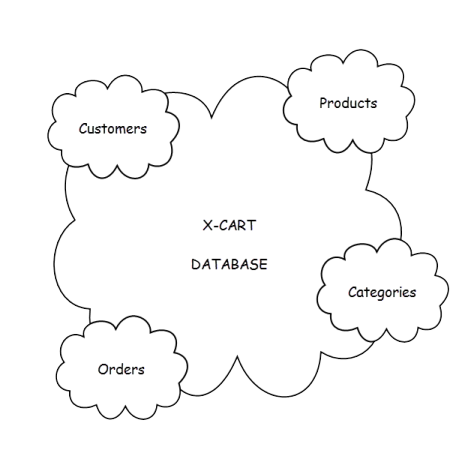Difference between revisions of "X-Cart:Database layout"
(→Categories) |
(→Categories) |
||
| Line 42: | Line 42: | ||
|} | |} | ||
| − | Coming up is the entity relationship diagram for the | + | Coming up is the entity relationship diagram for the Categories cluster. |
=== Orders === | === Orders === | ||
Revision as of 11:01, 11 November 2011
The current MySQL diagram for any X-Cart version with extensive comments can be found in the sql/xcart_tables.sql file.
The X-Cart database consists of four major clusters:
- Customers — information on users registered with your store, including customers, providers, partners and administrators.
- Products — product information, such as name, description, images, price, weight, etc.
- Categories — product category data.
- Orders — order details, including product, buyer, delivery and payment details, as well as related discount and gift options.
Each cluster has its own a set of data tables that are linked within the unit and with related tables in other units.
Contents
Customers
[coming up]
Products
[coming up]
Categories
Relationships in the Categories cluster
| Table column | Referenced by |
|---|---|
| xcart_categories.categoryid | xcart_categories_lng.categoryid |
| xcart_categories_subcount.categoryid | |
| xcart_category_bookmarks.categoryid | |
| xcart_category_memberships.categoryid | |
| xcart_discount_coupons.categoryid | |
| xcart_featured_products.categoryid | |
| xcart_products_categories.categoryid |
Coming up is the entity relationship diagram for the Categories cluster.
Orders
In an X-Cart based store, customers purchase products by placing orders. An order is a collection of information about a purchase, which includes:
- Information on product items being purchased (product titles, quantities, prices).
- Information on the customer who is making the purchase (personal information, billing and shipping addresses, contact information).
- Information about the method of delivery selected by the customer (name of method, shipping cost).
- Information about the payment method selected by the customer (name of method, payment details).
- Discounts, coupon codes or gift certificates applied.
- Total amount.
Each order has its unique order id number and, at any moment in time, is characterized by a status.
Relationships in the Orders cluster
| Table column | Referenced by |
|---|---|
| xcart_orders.orderid | xcart_partner_adv_orders.orderid |
| xcart_partner_payment.orderid | |
| xcart_partner_product_commissions.orderid | |
| xcart_provider_commissions.orderid | |
| xcart_provider_product_commissions.orderid | |
| xcart_shipping_labels.orderid | |
| xcart_split_checkout.orderid | |
| xcart_amazon_orders.orderid | |
| xcart_gcheckout_orders.orderid | |
| xcart_order_details.orderid | |
| xcart_order_extras.orderid | |
| xcart_order_status_history.orderid |
Coming up is the entity relationship diagram for the Orders cluster.
